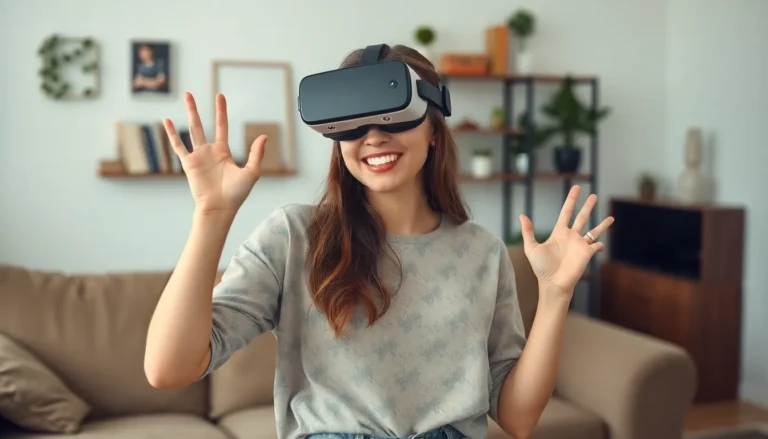Virtual reality development is like stepping into a sci-fi movie where the only limit is your imagination. With technology evolving faster than a cat meme goes viral, VR is transforming how we interact with digital worlds. Whether it’s gaming, training simulations, or even virtual travel, the possibilities are endless—and let’s be honest, who wouldn’t want to explore the depths of the ocean or soar through space without leaving their couch?
Table of Contents
ToggleOverview of Virtual Reality Development
Virtual reality development encompasses the creation of immersive digital environments that simulate real or imagined scenarios. Developers utilize various tools and technologies to design experiences that engage users on multiple sensory levels. Tools like Unity or Unreal Engine are commonly used for building VR applications, providing essential frameworks for creating realistic graphics and interactions.
Various platforms host virtual reality applications, including headsets like Oculus Rift, HTC Vive, and PlayStation VR. Each device offers unique capabilities and challenges. Developers often focus on optimizing performance and user experience across these platforms to reach a broader audience.
Content creation plays a significant role in virtual reality development. Storytelling techniques must adapt to the 360-degree environments. Immersive narratives require a shift in traditional approaches, as interactivity takes center stage alongside rich visuals.
Applications of VR are diverse, spanning industries such as education, healthcare, and entertainment. Training simulations in various fields enable users to practice real-life skills safely. In healthcare, VR assists with therapeutic interventions, providing patients with controlled exposure to phobias or anxiety-inducing situations. The gaming industry continues to lead VR innovation by creating engaging experiences that transport players into alternate realities.
Collaboration among developers, designers, and users fosters innovation in virtual reality. Feedback loops serve to enhance the development process, ensuring products meet user expectations. As technology advances, the potential for new applications of VR remains vast, expanding the horizon of possibilities for both creators and users alike.
Key Technologies in Virtual Reality Development

Advancements in virtual reality rely on a combination of hardware and software technologies that create immersive experiences. Each component plays a critical role in realizing the full potential of VR.
Hardware Components
Headsets serve as the primary hardware in VR experiences, providing users with visuals that transport them to different worlds. Popular options, like Oculus Rift, HTC Vive, and PlayStation VR, offer distinct features and comfort levels. Motion controllers enhance interactivity, allowing users to engage with environments through precise movements. Tracking sensors improve spatial awareness, creating a seamless connection between user actions and digital responses. High-performance computers or consoles support graphical fidelity, ensuring that visuals remain smooth and engaging.
Software Tools and Platforms
Developers utilize powerful software tools to create VR content. Unity and Unreal Engine serve as popular choices for building immersive environments due to their extensive features and user-friendly interfaces. 3D modeling software, like Blender and Autodesk Maya, aids in crafting detailed assets that populate virtual spaces. For content distribution, platforms such as SteamVR and Oculus Store facilitate access for users to experience VR applications. Ensuring optimized performance requires developers to adapt software for various hardware configurations, resulting in enhanced user experiences.
The Development Process
The development process in virtual reality involves multiple stages, partnering creativity with technology. Each phase is crucial for creating immersive experiences.
Conceptualization and Design
Conceptualization starts with identifying the purpose and objectives of the VR project. Developers outline the target audience and the specific experiences that resonate with users. Designers create storyboards and mockups, visualizing the user journey through the virtual space. They emphasize interactivity, ensuring users engage with the environment meaningfully. Integration of user feedback during this stage informs decision-making and shapes the design. Tools for creating these experiences often include 3D modeling software, allowing detailed asset creation. Collaboration among teams fosters innovative ideas and approaches, enhancing overall project quality.
Prototyping and Testing
Prototyping involves building a preliminary version of the VR application. Developers focus on core functionalities to demonstrate key concepts and interactions. Testing the prototype with real users reveals strengths and weaknesses in the design. This feedback loop highlights areas for improvement, ensuring the final product meets user expectations. Regular iterations allow teams to refine the experience based on insights gathered during testing phases. Taking performance metrics seriously helps optimize the application for various VR platforms. Ultimately, this process enhances usability and immersiveness, paving the way for a successful VR experience.
Challenges in Virtual Reality Development
Virtual reality development faces several challenges that developers must navigate to create effective experiences.
Technical Limitations
Technical limitations affect VR hardware and software significantly. Processing power plays a crucial role, as intensive graphics demand high-performance computers or consoles. Frame rates must remain consistent, usually around 60 to 90 frames per second, to avoid motion sickness. Developers often contend with issues related to headset resolution, which can impact visual clarity and immersion. Tracking accuracy represents another challenge; reliable motion tracking is essential to ensure user movements translate smoothly into the digital environment. Latency must also be minimized, as delays in responsiveness can disrupt the user experience and break immersion.
User Experience Considerations
User experience design remains vital in virtual reality development. Comfort during prolonged use can greatly affect engagement; developers should consider ergonomic design choices for headsets and controllers. Interaction methods must facilitate intuitive navigation within 3D spaces. Clear feedback mechanisms, such as haptic signals, can enhance the sense of presence. Developers often need to balance complex visuals with usability, ensuring that environments do not overwhelm users. Accessibility features play an essential role, as developers strive to accommodate users with different abilities and preferences. Prioritizing these factors leads to more successful and enjoyable virtual reality experiences.
Future Trends in Virtual Reality Development
Continuous advancements shape the future of virtual reality development. The integration of artificial intelligence enhances user interaction within immersive environments. Increased adoption of cloud computing facilitates access to high-quality VR content, reducing the burden on local devices. Developers focus on creating more social experiences, enabling users to connect and engage in shared virtual spaces.
Emerging technologies also expand the possibilities for VR applications. 5G networks will improve connectivity, resulting in lower latency and smoother experiences. Greater resolutions in displays enhance visual clarity, making simulations more lifelike. This shift towards ultra-realistic graphics captivates users and industries alike.
Collaboration tools within VR continue gaining traction, supporting remote teamwork and virtual meetings. Companies leverage these tools to increase productivity and foster innovation. Educational institutions incorporate VR for interactive learning modules, helping students grasp complex subjects through hands-on experience.
Accessibility in VR remains a priority, as developers aim to create inclusive environments. Simplified interfaces and adaptive controls cater to diverse user needs, ensuring broad usability. Ongoing research into motion sickness mitigation strategies will improve comfort across varying user demographics.
Sustainability efforts are also influencing VR development, with a focus on energy-efficient hardware and eco-friendly software practices. This commitment to environmental responsibility resonates with users concerned about climate impacts.
Investment in VR startups reveals optimism around the technology’s potential. Venture capitalists actively seek out new projects, anticipating significant returns in the expanding market. As these trends unfold, they will undoubtedly shape the landscape of virtual reality development in the years ahead.
The landscape of virtual reality development is evolving at an unprecedented pace. As technology continues to advance, the potential for immersive experiences grows, opening doors to innovative applications across various industries. Developers are harnessing powerful tools and collaborative approaches to create engaging content that captivates users.
With a focus on user experience and accessibility, VR is set to transform how people interact with digital environments. The integration of artificial intelligence and cloud computing is further enhancing these experiences, paving the way for a more connected and interactive future. As investment in VR technologies surges, the industry stands on the brink of a new era filled with possibilities.




